

Collocations With "HYPOTHESIS" in English
- Collocation Dictionary
- HYPOTHESIS collocations
hypothesis noun ADJ. acceptable, plausible | bold Scientists have proposed a bold hypothesis. | unlikely | speculative | testable | working These observations appear to support our working hypothesis. | scientific VERB + HYPOTHESIS construct, form, formulate, have, make, propose, put forward, suggest It is possible to make a hypothesis on the basis of this graph. A number of hypotheses have been put forward. | consider, discuss, examine, test (out) using this data to test her hypothesis | confirm, prove, support | accept | reject None of the hypotheses can be rejected at this stage. VERB + HYPOTHESIS concern sth Her hypothesis concerns the role of electromagnetic radiation. | predict sth The hypothesis predicts that children will perform better on task A than on task B. PREP. on a/the ~ Her study is based on the hypothesis that language simplification is possible. | ~ about an interesting hypothesis about the development of language | ~ on The results confirmed his hypothesis on the use of modal verbs.

What is a collocation?
A collocation is two or more words that often go together. These combinations (for example collocations with “HYPOTHESIS” ) just sound “right” to native English speakers, who use them all the time. On the other hand, other combinations of “HYPOTHESIS” may be unnatural and just sound “wrong”.
Using collocations list of “HYPOTHESIS” improves your English, especially your English speaking skills, and increases your vocabulary words in English.
Why learn collocations with “HYPOTHESIS” ?
- When using collocations with “HYPOTHESIS” , Your language will be more natural and more easily understood.
- You will have alternative and richer ways of expressing yourself.
- It is easier for our brains to remember and use language in chunks or blocks such as Common Collocations with “HYPOTHESIS” rather than as single words ( HYPOTHESIS | Translation, Meaning in Persian (Farsi) )
How to learn collocations with “HYPOTHESIS” ?
- Be aware of collocations with HYPOTHESIS , and try to recognize them when you see or hear them.
- Treat collocations as single blocks of language. Think of them as individual blocks or chunks, and learn strongly support, not strongly + support.
- When you learn a new word ( e.g. HYPOTHESIS | Translation, Meaning in Persian (Farsi) ), write down other words that collocate with it.
- Read as much as possible. Reading is an excellent way to learn vocabulary and collocations of “HYPOTHESIS” in context and naturally.
- Revise what you learn regularly. Practice using new collocations with “HYPOTHESIS” in context as soon as possible after learning them.
- Learn collocations with “ HYPOTHESIS ” in groups that work for you. You could learn them by topic (time, number, weather, money, family) or by a particular word (take action, take a chance, take an exam).
Types of collocation with “HYPOTHESIS”
- adverb + adjective: completely satisfied (NOT downright satisfied)
- adjective + noun: excruciating pain (NOT excruciating joy)
- noun + noun: a surge of anger (NOT a rush of anger)
- noun + verb: lions roar (NOT lions shout)
- verb + noun: commit suicide (NOT undertake suicide)
- verb + expression with preposition: burst into tears (NOT blow up in tears)
- verb + adverb: wave frantically (NOT wave feverishly)
Using Collocations of HYPOTHESIS to Boost Your IELTS Score
The correct use of collocations of “HYPOTHESIS” is an essential part of improving your English level and boosting your IELTS score. Using collocations + “HYPOTHESIS” in sentence examples correctly allows you to write and speak more like a native speaker and they are also one of the things that examiners look out for when marking your tests.
HYPOTHESIS Collocation Frequently Asked Questions
Why are HYPOTHESIS collocations important? HYPOTHESIS collocations are important because they make your language sound natural. If you master HYPOTHESIS collocations, your English will be more idiomatic, that is, more similar to the way it is spoken by native speakers. It is acknowledged that knowledge of HYPOTHESIS collocations helps to improve learners' language skills, enhance learners' communicative competence, and achieve native-like fluency.
- What is the importance of learning "HYPOTHESIS" collocation?
- what is the purpose of "hypothesis" collocation, - why is "hypothesis" collocation important in the language teaching and learning, - what are the features of collocations, - what is "hypothesis" collocation, - why learn "hypothesis" collocations, - how to learn "hypothesis" collocations.
- Collocation
- the word which collocates with HYPOTHESIS is
- HYPOTHESIS collocative word
- collocation word HYPOTHESIS examples
- HYPOTHESIS collocation
- collocative word for HYPOTHESIS
- the word that collocates with HYPOTHESIS is
- HYPOTHESIS collective words
- collocative word of HYPOTHESIS
- collocations with HYPOTHESIS
- 50000 in words
- 15000 in words
- 20000 in words
- 40000 in words
- 25000 in words
- 10000 in words
- such as in a sentence
- likewise in a sentence
- moreover in a sentence
- apathy in a sentence
- whereas in a sentence
- nostalgia in a sentence

The English language is considered one of the hardest languages to learn. It is rife with similarly spelled words with completely different meanings and complex sentences. There are hard and fast rules to the language, then there are bits of language that have no rhyme or reason, making even native English language speakers scratch their heads and wonder if they’re right or not.
Collocations fall in the latter category. If you’ve never heard of this term, you’re not alone. It’s not something taught in detail in the average English curriculum. A collocation is defined as two or more words that join together to form a unique meaning that is readily understood by English speakers but probably not by those who speak it as a second language. In many cases, the speaker isn’t aware of the collocation. They’re simply repeating a phrase they’ve heard during prolonged exposure to the English language.
While the scientific community is composed of different nations and languages, journals are primarily published in English. English was adopted centuries ago as the communal and universal language for scholars and researchers, back when it was the most common second language learned by those in medical and business industries.
Of course, a vast percentage of researchers aren’t native English speakers, which means that many higher education articles are written with English as the author’s second language. This can cause translation problems, particularly when using collocations, which can’t be replaced with a synonym.
Understanding Collocations
There are two types of collocations - a weak one and a strong one. A collocation is pairing one or more words together to create a particular meaning. A weak collocation includes a word that pairs with many other words within the English language.
A strong collocation is comprised of at least one word that doesn’t pair well with others. For example, blonde hair is a strong collocation because blonde doesn’t pair with many other English words.
How to Write a Collocation
Collocations can be difficult to teach and to learn. They are inherently part of a native English speaker’s language to the point they may not even notice the collocation. There may not be strict rules regarding collocations, but there are guidelines to follow instead of mashing two random words together.
Of course, to non-native English speakers, the words in the collocation will seem like randomized word pairings. There are at least six types of collocations.
Adjective + noun
Example: She was in excruciating pain after the car accident.
Noun + verb
Example: People in the South are relieved when temperatures fall .
Verb + noun
Example: The happy couple couldn’t wait to get married and spend their lives together.
Verb + adverb
Example: I can vaguely remember her face, but not her name.
Adverb + adjective
Example: She was completely satisfied with the house renovations.
Noun + noun
Example: He felt a surge of anger when a classmate plagiarized his work.
Academic writing is much more complex than the above examples. How should scholars incorporate collocations into their academic papers?
Common Collocation Phrases Used in Academics and Their Improper Counterparts
A scholar or researcher likely defaults to their academic vocabulary when comprising their findings into a research paper. The text of the paper must be accessible to all readers, even when explaining complex ideas. Collocations are commonly used in academic papers.
But those common phrases won’t have the same meaning if replaced with a synonym. What are some of the most frequent collocations used in academic writing? And which phrases don’t pair well together? Here’s one example of an academic collocation:
Correct Collocation: A scholar’s job is to search for evidence that supports their hypothesis.
Improper Collocation: A scholar’s job is to research evidence that supports their hypothesis.
If you’re unsure about how to use collocations, several online collocation dictionaries can help.
- Afghanistan
- Åland Islands
- American Samoa
- Antigua and Barbuda
- Bolivia (Plurinational State of)
- Bonaire, Sint Eustatius and Saba
- Bosnia and Herzegovina
- Bouvet Island
- British Indian Ocean Territory
- Brunei Darussalam
- Burkina Faso
- Cayman Islands
- Central African Republic
- Christmas Island
- Cocos (Keeling) Islands
- Congo (Democratic Republic of the)
- Cook Islands
- Côte d'Ivoire
- Curacao !Curaçao
- Dominican Republic
- El Salvador
- Equatorial Guinea
- Falkland Islands (Malvinas)
- Faroe Islands
- French Guiana
- French Polynesia
- French Southern Territories
- Guinea-Bissau
- Heard Island and McDonald Islands
- Iran (Islamic Republic of)
- Isle of Man
- Korea (Democratic Peoples Republic of)
- Korea (Republic of)
- Lao People's Democratic Republic
- Liechtenstein
- Marshall Islands
- Micronesia (Federated States of)
- Moldova (Republic of)
- Netherlands
- New Caledonia
- New Zealand
- Norfolk Island
- North Macedonia
- Northern Mariana Islands
- Palestine, State of
- Papua New Guinea
- Philippines
- Puerto Rico
- Russian Federation
- Saint Barthélemy
- Saint Helena, Ascension and Tristan da Cunha
- Saint Kitts and Nevis
- Saint Lucia
- Saint Martin (French part)
- Saint Pierre and Miquelon
- Saint Vincent and the Grenadines
- Sao Tome and Principe
- Saudi Arabia
- Sierra Leone
- Sint Maarten (Dutch part)
- Solomon Islands
- South Africa
- South Georgia and the South Sandwich Islands
- South Sudan
- Svalbard and Jan Mayen
- Switzerland
- Syrian Arab Republic
- Tanzania, United Republic of
- Timor-Leste
- Trinidad and Tobago
- Turkmenistan
- Turks and Caicos Islands
- United Arab Emirates
- United Kingdom of Great Britain and Northern Ireland
- United States of America
- United States Minor Outlying Islands
- Venezuela (Bolivarian Republic of)
- Virgin Islands (British)
- Virgin Islands (U.S.)
- Wallis and Futuna
- Western Sahara
- Take our quick quizzes to practise your vocabulary.
- We have thousands of six-question quizzes to try.
- Choose from collocations, synonyms, phrasal verbs and more.
More results
- null hypothesis

Explore topics
- Environment & waste

- school Campus Bookshelves
- menu_book Bookshelves
- perm_media Learning Objects
- login Login
- how_to_reg Request Instructor Account
- hub Instructor Commons
- Download Page (PDF)
- Download Full Book (PDF)
- Periodic Table
- Physics Constants
- Scientific Calculator
- Reference & Cite
- Tools expand_more
- Readability
selected template will load here
This action is not available.

7.1: Collocates
- Last updated
- Save as PDF
- Page ID 81928

- Anatol Stefanowitsch
- Freie Universität Berlin via Language Science Press
The (orthographic) word plays a central role in corpus linguistics. As suggested in Chapter 4, this is in no small part due to the fact that all corpora, whatever additional annotations may have been added, consist of orthographically represented language. This makes it easy to retrieve word forms. Every concordancing program offers the possibility to search for a string of characters – in fact, some are limited to this kind of query.
However, the focus on words is also due to the fact that the results of corpus linguistic research quickly showed that words (individually and in groups) are more interesting and show a more complex behavior than traditional, grammar-focused theories of language assumed. An area in which this is very obvious, and which has therefore become one of the most heavily researched areas in corpus linguistics, is the way in which words combine to form so-called collocations .
This chapter is dedicated entirely to the discussion of collocation. At first, this will seem like a somewhat abrupt shift from the topics and phenomena we have discussed so far – it may not even be immediately obvious how they fit into the definition of corpus linguistics as “the investigation of linguistic research questions that have been framed in terms of the conditional distribution of linguistic phenomena in a linguistic corpus”, which was presented at the end of Chapter 2. However, a closer look will show that studying the co-occurrence of words and/ or word forms is simply a special case of precisely this kind of research program.
7.1 Collocates
Trivially, texts are not random sequences of words. There are several factors influencing the likelihood of two (or more) words occurring next to each other.
First, the co-occurrence of words in a sequence is restricted by grammatical considerations. For example, a definite article cannot be followed by another definite article or a verb, but only by a noun, by an adjective modifying a noun, by an adverb modifying such an adjective or by a post-determiner. Likewise, a transitive verb requires a direct object in the form of a noun phrase, so – barring cases where the direct object is pre- or post-posed – it will be followed by a word that can occur at the beginning of a noun phrase (such as a pronoun, a determiner, an adjective or a noun).
Second, the co-occurrence of words is restricted by semantic considerations. For example, the transitive verb drink requires a direct object referring to a liquid, so it is probable that it will be followed by words like water , beer , coffee , poison , etc., and improbable that it will be followed by words like bread , guitar , stone , democracy , etc. Such restrictions are treated as a grammatical property of words (called selection restrictions ) in some theories, but they may also be an expression of our world knowledge concerning the activity of drinking.
Finally, and related to the issue of world knowledge, the co-occurrence of words is restricted by topical considerations. Words will occur in sequences that correspond to the contents we are attempting to express, so it is probable that co-occurring content words will come from the same discourse domain.
However, it has long been noted that words are not distributed randomly even within the confines of grammar, lexical semantics, world knowledge, and communicative intent. Instead, a given word will have affinities to some words, and disaffinities to others, which we could not predict given a set of grammatical rules, a dictionary and a thought that needs to be expressed. One of the first principled discussions of this phenomenon is found in Firth (1957). Using the example of the word ass (in the sense of ‘donkey’), he discusses the way in which what he calls habitual collocations contribute to the meaning of words:
One of the meanings of ass is its habitual collocation with an immediately preceding you silly , and with other phrases of address or of personal reference. ... There are only limited possibilities of collocation with preceding adjectives, among which the commonest are silly , obstinate , stupid , awful , occasionally egregious . Young is much more frequently found than old . (Firth 1957: 194f)
Note that Firth, although writing well before the advent of corpus linguistics, refers explicitly to frequency as a characteristic of collocations. The possibility of using frequency as part of the definition of collocates, and thus as a way of identifying them, was quickly taken up. Halliday (1961) provides what is probably the first strictly quantitative definition (cf. also Church & Hanks (1990) for a more recent comprehensive quantitative discussion):
Collocation is the syntagmatic association of lexical items, quantifiable, textually, as the probability that there will occur, at n removes (a distance of n lexical items) from an item x, the items a, b, c... Any given item thus enters into a range of collocation, the items with which it is collocated being ranged from more to less probable... (Halliday 1961: 276)
7.1.1 Collocation as a quantitative phenomenon
Essentially, then, collocation is just a special case of the quantitative corpus linguistic research design adopted in this book: to ask whether two words form a collocation (or: are collocates of each other) is to ask whether one of these words occurs in a given position more frequently than expected by chance under the condition that the other word occurs in a structurally or sequentially related position. In other words, we can decide whether two words a and b can be regarded as collocates on the basis of a contingency table like that in Table 7.1. The FIRST POSITION in the sequence is treated as the dependent variable, with two values: the word we are interested in (here: WORD A), and all OTHER words. The SECOND POSITION is treated as the independent variable, again, with two values: the word we are interested in (here: WORD B), and all OTHER words (of course, it does not matter which word we treat as the dependent and which as the independent variable, unless our research design suggests a particular reason). 1
Table 7.1: Collocation

On the basis of such a table, we can determine the collocation status of a given word pair. For example, we can ask whether Firth was right with respect to the claim that silly ass is a collocation. The necessary data are shown in Table 7.2: As discussed above, the dependent variable is the FIRST POSITION in the sequence, with the values SILLY and ¬SILLY (i.e., all words that are not ass ); the independent variable is the SECOND POSITION in the sequence, with the values ASS and ¬ASS.
Table 7.2: Co-occurrence of silly and ass in the BNC
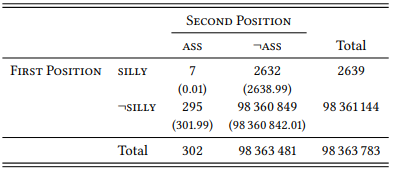
The combination silly ass is very rare in English, occurring just seven times in the 98 363 783 word BNC, but the expected frequencies in Table 7.2 show that this is vastly more frequent than should be the case if the words co-occurred randomly – in the latter case, the combination should have occurred just 0.01 times (i.e., not at all). The difference between the observed and the expected frequencies is highly significant (χ 2 = 6033.8, df = 1, p < 0.001). Note that we are using the χ 2 test here because we are already familiar with it. However, this is not the most useful test for the purpose of identifying collocations, so we will discuss better options below.
Generally speaking, the goal of a quantitative collocation analysis is to identify, for a given word, those other words that are characteristic for its context of usage. Tables 7.1 and 7.2 present the most straightforward way of doing so: we simply compare the frequency with which two words co-occur to the frequencies with which they occur in the corpus in general. In other words, the two conditions across which we are investigating the distribution of a word are “next to a given other word” and “everywhere else”. This means that the corpus itself functions as a kind of neutral control condition, albeit a somewhat indiscriminate one: comparing the frequency of a word next to some other word to its frequency in the entire rest of the corpus is a bit like comparing an experimental group of subjects that have been given a particular treatment to a control group consisting of all other people who happen to live in the same city.
Often, we will be interested in the distribution of a word across two specific conditions – in the case of collocation, the distribution across the immediate contexts of two semantically related words. It may be more insightful to compare adjectives occurring next to ass with those occurring next to the rough synonym donkey or the superordinate term animal . Obviously, the fact that silly occurs more frequently with ass than with donkey or animal is more interesting than the fact that silly occurs more frequently with ass than with stone or democracy . Likewise, the fact that silly occurs with ass more frequently than childish is more interesting than the fact that silly occurs with ass more frequently than precious or parliamentary .
In such cases, we can modify Table 7.1 as shown in Table 7.3 to identify the collocates that differ significantly between two words. There is no established term for such collocates, so we we will call them differential collocates here 2 (the method is based on Church et al. 1991).
Table 7.3: Identifying differential collocates
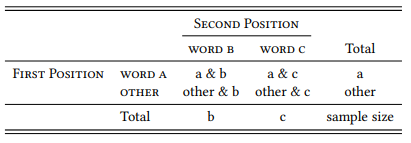
Since the collocation silly ass and the word ass in general are so infrequent in the BNC, let us use a different noun to demonstrate the usefulness of this method, the word game. We can speak of silly game(s) or childish game(s) , but we may feel that the latter is more typical than the former. The relevant lemma frequencies to put this feeling to the test are shown in Table 7.4.
Table 7.4: Childish game vs. silly game (lemmas) in the BNC
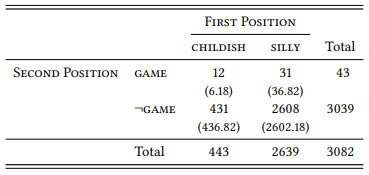
The sequences childish game(s) and silly game(s) both occur in the BNC. Both combinations taken individually are significantly more frequent than expected (you may check this yourself using the frequencies from Table 7.4, the total lemma frequency of game in the BNC (20 627), and the total number of words in the BNC given in Table 7.2 above). The lemma sequence silly game is more frequent, which might lead us to assume that it is the stronger collocation. However, the direct comparison shows that this is due to the fact that silly is more frequent in general than childish , making the combination silly game more probable than the combination childish game even if the three words were distributed randomly. The difference between the observed and the expected frequencies suggests that childish is more strongly associated with game(s) than silly . The difference is significant (χ 2 = 6.49, df = 1, p < 0.05).
Researchers differ with respect to what types of co-occurrence they focus on when identifying collocations. Some treat co-occurrence as a purely sequential phenomenon defining collocates as words that co-occur more frequently than expected within a given span. Some researchers require a span of 1 (i.e., the words must occur directly next to each other), but many allow larger spans (five words being a relatively typical span size).
Other researchers treat co-occurrence as a structural phenomenon, i.e., they define collocates as words that co-occur more frequently than expected in two related positions in a particular grammatical structure, for example, the adjective and noun positions in noun phrases of the form [Det Adj N] or the verb and noun position in transitive verb phrases of the form [V [ NP (Det) (Adj) N]]. 3 However, instead of limiting the definition to one of these possibilities, it seems more plausible to define the term appropriately in the context of a specific research question. In the examples above, we used a purely sequential definition that simply required words to occur next to each other, paying no attention to their word-class or structural relationship; given that we were looking at adjective-noun combinations, it would certainly have been reasonable to restrict our search parameters to adjectives modifying the noun ass , regardless of whether other adjectives intervened, for example in expressions like silly old ass , which our query would have missed if they occurred in the BNC (they do not).
It should have become clear that the designs in Tables 7.1 and 7.3 are essentially variants of the general research design introduced in previous chapters and used as the foundation of defining corpus linguistics: it has two variables, POSITION 1 and POSITION 2, both of which have two values, namely WORD X VS. OTHER WORDS (or, in the case of differential collocates, WORD X VS. WORD Y). The aim is to determine whether the value WORD A is more frequent for POSITION 1 under the condition that WORD B occurs in POSITION 2 than under the condition that other words (or a particular other word) occur in POSITION 2.
7.1.2 Methodological issues in collocation research
We may occasionally be interested in an individual pair of collocates, such as silly ass , or in a small set of such pairs, such as all adjective-noun pairs with ass as the noun. However, it is much more likely that we will be interested in large sets of collocate pairs, such as all adjective-noun pairs or even all word pairs in a given corpus. This has a number of methodological consequences concerning the practicability, the statistical evaluation and the epistemological status of collocation research.
a. Practicability . In practical terms, the analysis of large numbers of potential collocations requires creating a large number of contingency tables and subjecting them to the χ 2 test or some other appropriate statistical test. This becomes implausibly time-consuming very quickly and thus needs to be automated in some way.
There are concordancing programs that offer some built-in statistical tests, but they typically restrict our options quite severely, both in terms of the tests they allow us to perform and in terms of the data on which the tests are performed. Anyone who decides to become involved in collocation research (or some of the large-scale lexical research areas described in the next chapter), should get acquainted at least with the simple options of automatizing statistical testing offered by spreadsheet applications. Better yet, they should invest a few weeks (or, in the worst case, months) to learn a scripting language like Perl, Python or R (the latter being a combination of statistical software and programming environment that is ideal for almost any task that we are likely to come across as corpus linguists).
b. Statistical evaluation . In statistical terms, the analysis of large numbers of potential collocations requires us to keep in mind that we are now performing multiple significance tests on the same set of data. This means that we must adjust our significance levels. Think back to the example of coin-flipping: the probability of getting a series of one head and nine tails is 0.009765. If we flip a coin ten times and get this result, we could thus reject the null hypothesis with a probability of error of 0.010744, i.e., around 1 percent (because we would have to add the probability of getting ten tails, 0.000976). This is well below the level required to claim statistical significance. However, if we perform one hundred series of ten coin-flips and one of these series consists of one head and nine tails (or ten tails), we could not reject the null hypothesis with the same confidence, as a probability of 0.010744 means that we would expect one such series to occur by chance. This is not a problem as long as we do not accord this one result out of a hundred any special importance. However, if we were to identify a set of 100 collocations with p -values of 0.001 in a corpus, we are potentially treating all of them as important, even though it is very probable that at least one of them reached this level of significance by chance.
To avoid this, we have to correct our levels of significance when performing multiple tests on the same set of data. As discussed in Section 6.6.1 above, the simplest way to do this is the Bonferroni correction, which consists in dividing the conventionally agreed-upon significance levels by the number of tests we are performing. As noted in Section 6.6.1, this is an extremely conservative correction that might make it quite difficult for any given collocation to reach significance.
Of course, the question is how important the role of p -values is in a design where our main aim is to identify collocates and order them in terms of their collocation strength. I will turn to this point presently, but before I do so, let us discuss the third of the three consequences of large-scale testing for collocation, the methodological one.
c. Epistemological considerations . We have, up to this point, presented a very narrow view of the scientific process based (in a general way) on the Popperian research cycle where we formulate a research hypothesis and then test it (either directly, by looking for counterexamples, or, more commonly, by attempting to reject the corresponding null hypothesis). This is called the deductive method. However, as briefly discussed in Chapter 3, there is an alternative approach to scientific research that does not start with a hypothesis, but rather with general questions like “Do relationships exist between the constructs in my data?” and “If so, what are those relationships?”. The research then consists in applying statistical procedures to large amounts of data and examining the results for interesting patterns. As electronic storage and computing power have become cheaper and more widely accessible, this approach – the exploratory or inductive approach – has become increasingly popular in all branches of science, particularly the social sciences. It would be surprising if corpus linguistics was an exception, and indeed, it is not. Especially the area of collocational research is typically exploratory.
In principle, there is nothing wrong with exploratory research – on the contrary, it would be unreasonable not to make use of the large amounts of language data and the vast computing power that has become available and accessible over the last thirty years. In fact, it is sometimes difficult to imagine a plausible hypothesis for collocational research projects. What hypothesis would we formulate before identifying all collocations in the LOB or some specialized corpus (e.g., a corpus of business correspondence, a corpus of flight-control communication or a corpus of learner language)? 4 Despite this, it is clear that the results of such a collocation analysis yield interesting data, both for practical purposes (building dictionaries or teaching materials for business English or aviation English, extracting terminology for the purpose of standardization, training natural-language processing systems) and for theoretical purposes (insights into the nature of situational language variation or even the nature of language in general).
But there is a danger, too: Most statistical procedures will produce some statistically significant result if we apply them to a large enough data set, and collocational methods certainly will. Unless we are interested exclusively in description, the crucial question is whether these results are meaningful. If we start with a hypothesis, we are restricted in our interpretation of the data by the need to relate our data to this hypothesis. If we do not start with a hypothesis, we can interpret our results without any restrictions, which, given the human propensity to see patterns everywhere, may lead to somewhat arbitrary post-hoc interpretations that could easily be changed, even reversed, if the results had been different and that therefore tell us very little about the phenomenon under investigation or language in general. Thus, it is probably a good idea to formulate at least some general expectations before doing a large-scale collocation analysis.
Even if we do start out with general expectations or even with a specific hypothesis, we will often discover additional facts about our phenomenon that go beyond what is relevant in the context of our original research question. For example, checking in the BNC Firth’s claim that the most frequent collocates of ass are silly , obstinate , stupid , awful and egregious and that young is “much more frequent” than old , we find that silly is indeed the most frequent adjectival collocate, but that obstinate , stupid and egregious do not occur at all, that awful occurs only once, and that young and old both occur twice. Instead, frequent adjectival collocates (ignoring second-placed wild , which exclusively refers to actual donkeys), are pompous and bad . Pompous does not really fit with the semantics that Firth’s adjectives suggest and could indicate that a semantic shift from ‘stupidity’ to ‘self-importance’ may have taken place between 1957 and 1991 (when the BNC was assembled).
This is, of course, a new hypothesis that can (and must) be investigated by comparing data from the 1950s and the 1990s. It has some initial plausibility in that the adjectives blithering , hypocritical , monocled and opinionated also co-occur with ass in the BNC but are not mentioned by Firth. However, it is crucial to treat this as a hypothesis rather than a result. The same goes for bad ass which suggests that the American sense of ass (‘bottom’) and/or the American adjective badass (which is often spelled as two separate words) may have begun to enter British English. In order to be tested, these ideas – and any ideas derived from an exploratory data analysis – have to be turned into testable hypotheses and the constructs involved have to be operationalized. Crucially, they must be tested on a new data set – if we were to circularly test them on the same data that they were derived from, we would obviously find them confirmed.
7.1.3 Effect sizes for collocations
As mentioned above, significance testing (while not without its uses) is not necessarily our primary concern when investigating collocations. Instead, researchers frequently need a way of assessing the strength of the association between two (or more) words, or, put differently, the effect size of their co-occurrence (recall from Chapter 6 that significance and effect size are not the same). A wide range of such association measures has been proposed and investigated. They are typically calculated on the basis of (some or all) the information contained in contingency tables like those in Tables 7.1 and 7.3 above.
Let us look at some of the most popular and/or most useful of these measures. I will represent the formulas with reference to the table in Table 7.5, i.e, O 11 means the observed frequency of the top left cell, E 11 its expected frequency, R 1 the first row total, C 2 the second column total, and so on. Note that second column would be labeled OTHER WORDS in the case of normal collocations, and WORD C in the case of differential collocations. The association measures can be applied to both kinds of design.
Table 7.5: A generic 2-by-2 table for collocation research
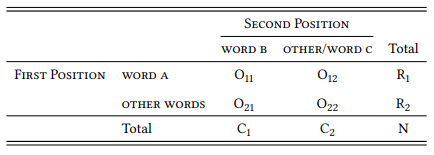
Now all we need is a good example to demonstrate the calculations. Let us use the adjective-noun sequence good example from the LOB corpus (but horse lovers need not fear, we will return to equine animals and their properties below).
Table 7.6: Co-occurrence of good and example in the LOB
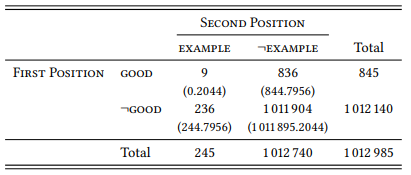
Measures of collocation strength differ with respect to the data needed to calculate them, their computational intensiveness and, crucially, the quality of their results. In particular, many measures, notably the ones easy to calculate, have a problem with rare collocations, especially if the individual words of which they consist are also rare. After we have introduced the measures, we will therefore compare their performance with a particular focus on the way in which they deal (or fail to deal) with such rare events.
7.1.3.1 Chi-square
The first association measure is an old acquaintance: the chi-square statistic, which we used extensively in Chapter 6 and in Section 7.1.1 above. I will not demonstrate it again, but the chi-square value for Table 7.6 would be 378.95 (at 1 degree of freedom this means that p < 0.001, but we are not concerned with p -values here).
Recall that the chi-square test statistic is not an effect size, but that it needs to be divided by the table total to turn it into one. As long as we are deriving all our collocation data from the same corpus, this will not make a difference, since the table total will always be the same. However, this is not always the case. Where table sizes differ, we might consider using the phi value instead. I am not aware of any research using phi as an association measure, and in fact the chi-square statistic itself is not used widely either. This is because it has a serious problem: recall that it cannot be applied if more than 20 percent of the cells of the contingency table contain expected frequencies smaller than 5 (in the case of collocates, this means not even one out of the four cells of the 2-by-2 table). One reason for this is that it dramatically overestimates the effect size and significance of such events, and of rare events in general. Since collocations are often relatively rare events, this makes the chi-square statistic a bad choice as an association measure.
7.1.3.2 Mutual Information
Mutual information is one of the oldest collocation measures, frequently used in computational linguistics and often implemented in collocation software. It is given in (1) in a version based on Church & Hanks (1990): 5

Applying the formula to our table, we get the following:

In our case, we are looking at cases where WORD A and WORD B occur directly next to each other, i.e., the span size is 1. When looking at a larger span (which is often done in collocation research), the probability of encountering a particular collocate increases, because there are more slots that it could potentially occur in. The MI statistic can be adjusted for larger span sizes as follows (where S is the span size):

The mutual information measure suffers from the same problem as the χ 2 statistic: it overestimates the importance of rare events. Since it is still fairly widespread in collocational research, we may nevertheless need it in situations where we want to compare our own data to the results of published studies. However, note that there are versions of the MI measure that will give different results, so we need to make sure we are using the same version as the study we are comparing our results to. But unless there is a pressing reason, we should not use mutual information at all.
7.1.3.3 The log-likelihood ratio test
The G value of the log-likelihood ratio test is one of the most popular – perhaps the most popular – association measure in collocational research, found in many of the central studies in the field and often implemented in collocation software. The following is a frequently found form (Read & Cressie 1988: 134):

In order to calculate the G measure, we calculate for each cell the natural logarithm of the observed frequency divided by the expected frequency and multiply it by the observed frequency. We then add up the results for all four cells and multiply the result by two. Note that if the observed frequency of a given cell is zero, the expression O i / Ei will, of course, also be zero. Since the logarithm of zero is undefined, this would result in an error in the calculation. Thus, log(0) is simply defined as zero when applying the formula in (3).
Applying the formula in (3) to the data in Table 7.6, we get the following:

The G value has long been known to be more reliable than the χ 2 test when dealing with small samples and small expected frequencies (Read & Cressie 1988: 134ff). This led Dunning (1993) to propose it as an association measure specifically to avoid the overestimation of rare events that plagues the χ 2 test, mutual information and other measures.
7.1.3.4 Minimum Sensitivity
Minimum sensitivity was proposed by Pedersen (1998) as potentially useful measure especially for the identification of associations between content words:

We simply divide the observed frequency of a collocation by the frequency of the first word (R 1 ) and of the second word (C 1 ) and use the smaller of the two as the association measure. For the data in Table 7.6, this gives us the following:

In addition to being extremely simple to calculate, it has the advantage of ranging from zero (words never occur together) to 1 (words always occur together); it was also argued by Wiechmann (2008) to correlate best with reading time data when applied to combinations of words and grammatical constructions (see Chapter 8). However, it also tends to overestimate the importance of rare collocations.
7.1.3.5 Fisher’s exact test
isher’s exact test was already mentioned in passing in Chapter 6 as an alternative to the χ 2 test that calculates the probability of error directly by adding up the probability of the observed distribution and all distributions that deviate from the null hypothesis further in the same direction. Pedersen (1996) suggests using this p -value as a measure of association because it does not make any assumptions about normality and is even better at dealing with rare events than G. Stefanowitsch & Gries (2003: 238–239) add that it has the advantage of taking into account both the magnitude of the deviation from the expected frequencies and the sample size.
There are some practical disadvantages to Fisher’s exact test. First, it is computationally expensive – it cannot be calculated manually, except for very small tables, because it involves computing factorials, which become very large very quickly. For completeness’ sake, here is (one version of) the formula:

Obviously, it is not feasible to apply this formula directly to the data in Table 7.6, because we cannot realistically calculate the factorials for 236 or 836, let alone 1 011 904. But if we could, we would find that the p -value for Table 7.6 is 0.000000000001188.
Spreadsheet applications do not usually offer Fisher’s exact test, but all major statistics applications do. However, typically, the exact p -value is not reported beyond the limit of a certain number of decimal places. This means that there is often no way of ranking the most strongly associated collocates, because their p -values are smaller than this limit. For example, there are more than 100 collocates in the LOB corpus with a Fisher’s exact p -value that is smaller than the smallest value that a standard-issue computer chip is capable of calculating, and more than 5000 collocates that have p -values that are smaller than what the standard implementation of Fisher’s exact test in the statistical software package R will deliver. Since in research on collocations we often need to rank collocations in terms of their strength, this may become a problem.
7.1.3.6 A comparison of association measures
Let us see how the association measures compare using a data set of 20 potential collocations. Inspired by Firth’s silly ass , they are all combinations of adjectives with equine animals. Table 7.7 shows the combinations and their frequencies in the BNC sorted by their raw frequency of occurrence (adjectives and nouns are shown in small caps here to stress that they are values of the variables Word A and Word B, but I will generally show them in italics in the remainder of the book in line with linguistic tradition).
All combinations are perfectly normal, grammatical adjective-noun pairs, meaningful not only in the specific context of their actual occurrence. However, I have selected them in such a way that they differ with respect to their status as potential collocations (in the sense of typical combinations of words). Some are compounds or compound like combinations ( rocking horse , Trojan horse , and, in specialist discourse, common zebra ). Some are the kind of semi-idiomatic combinations that Firth had in mind ( silly ass , pompous ass ). Some are very conventional combinations of nouns with an adjective denoting a property specific to that noun ( prancing horse , braying donkey , galloping horse – the first of these being a conventional way of referring to the Ferrari brand mark logo). Some only give the appearance of semi-idiomatic combinations ( jumped-up jackass , actually an unconventional variant of jumped-up jack-in-office ; dumb-fuck donkey , actually an extremely rare phrase that occurs only once in the documented history of English, namely in the book Trail of the Octopus: From Beirut to Lockerbie – Inside the DIA and that probably sounds like an idiom because of the alliteration and the semantic relationship to silly ass ; and monocled ass , which brings to mind pompous ass but is actually not a very conventional combination). Finally, there are a number of fully compositional combinations that make sense but do not have any special status ( caparisoned mule , new horse , old donkey , young zebra , large mule , female hinny , extinct quagga ).
Table 7.7: Some collocates of the form [ADJ N equine ] (BNC)
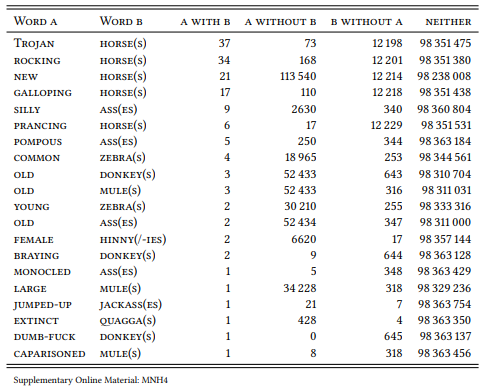
In addition, I have selected them to represent different types of frequency relations: some of them are (relatively) frequent, some of them very rare, for some of them the either the adjective or the noun is generally quite frequent, and for some of them neither of the two is frequent.
Table 7.8 shows the ranking of these twenty collocations by the five association measures discussed above. Simplifying somewhat, a good association measure should rank the conventionalized combinations highest ( rocking horse, Trojan horse, silly ass, pompous ass, prancing horse, braying donkey, galloping horse ), the distinctive sounding but non-conventionalized combinations somewhere in the middle ( jumped-up jackass, dumb-fuck donkey, old ass, monocled ass ) and the compositional combinations lowest ( common zebra, jumped-up jackass, dumb-fuck donkey, old ass, monocled ass ). Common zebra is difficult to predict – it is a conventionalized expression, but not in the general language.
Table 7.8: Comparison of selected association measures for collocates of the form [ADJ N equine ] (BNC)
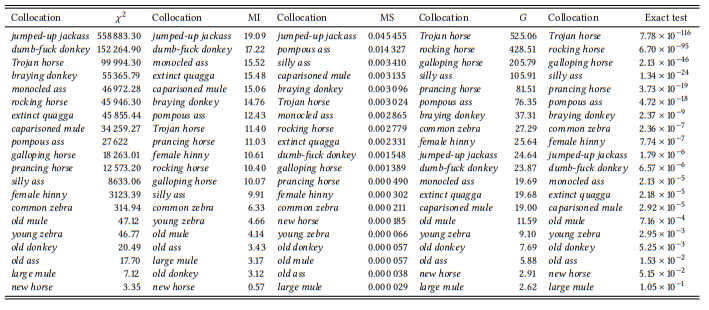
All association measures fare quite well, generally speaking, with respect to the compositional expressions – these tend to occur in the lower third of all lists. Where there are exceptions, the χ 2 statistic, mutual information and minimum sensitivity rank rare cases higher than they should (e.g. caparisoned mule , extinct quagga ), while the G and the p -value of Fisher’s exact test rank frequent cases higher (e.g. galloping horse ).
With respect to the non-compositional cases, χ 2 and mutual information are quite bad, overestimating rare combinations like jumped-up jackass, dumb-fuck donkey and monocled ass , while listing some of the clear cases of collocations much further down the list ( silly ass , and, in the case of MI, rocking horse ). Minimum sensitivity is much better, ranking most of the conventionalized cases in the top half of the list and the non-conventionalized ones further down (with the exception of jumped-up jackass , where both the individual words and their combination are very rare). The G and the Fisher p -value fare best (with no differences in their ranking of the expressions), listing the conventionalized cases at the top and the distinctive but non-conventionalized cases in the middle.
To demonstrate the problems that very rare events can cause (especially those where both the combination and each of the two words in isolation are very rare), imagine someone had used the phrase tomfool onager once in the BNC. Since neither the adjective tomfool (a synonym of silly) nor the noun onager (the name of the donkey sub-genus Equus hemionus, also known as Asiatic or Asian wild ass ) occur in the BNC anywhere else, this would give us the distribution in Table 7.9.
Table 7.9: Fictive occurrence of tomfool onager in the BNC
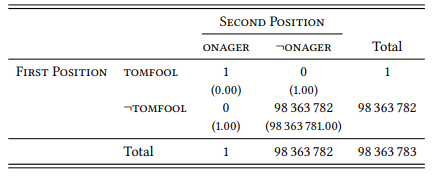
Applying the formulas discussed above to this table gives us a χ 2 value of 98 364 000, an MI value of 26.55 and a minimum sensitivity value of 1, placing this (hypothetical) one-off combination at the top of the respective rankings by a wide margin. Again, the log-likelihood ratio test and Fisher’s exact test are much better, putting in eighth place on both lists ( G = 36.81, p exact = 1.02 × 10 −8 ).
Although the example is hypothetical, the problem is not. It uncovers a mathematical weakness of many commonly used association measures. From an empirical perspective, this would not necessarily be a problem, if cases like that in Table 7.9 were rare in linguistic corpora. However, they are not. The LOB corpus, for example, contains almost one thousand such cases, including some legitimate collocation candidates (like herbal brews, casus belli or sub-tropical climates ), but mostly compositional combinations ( ungraceful typography, turbaned headdress, songs-of-Britain medley ), snippets of foreign languages ( freie Blicke, l’arbre rouge, palomita blanca ) and other things that are quite clearly not what we are looking for in collocation research. All of these will occur at the top of any collocate list created using statistics like χ 2 , mutual information and minimum sensitivity. In large corpora, which are impossible to check for orthographical errors and/or errors introduced by tokenization, this list will also include hundreds of such errors (whose frequency of occurrence is low precisely because they are errors).
To sum up, when doing collocational research, we should use the best association measures available. For the time being, this is the p value of Fisher’s exact test (if we have the means to calculate it), or G (if we don’t, or if we prefer using a widely-accepted association measure). We will use G through much of the remainder of this book whenever dealing with collocations or collocation-like phenomena.
1 Note that we are using the corpus size as the table total – strictly speaking, we should be using the total number of two-word sequences (bigrams) in the corpus, which will be lower: The last word in each file of our corpus will not have a word following it, so we would have to subtract the last word of each file – i.e., the number of files in our corpus – from the total. This is unlikely to make much of a difference in most cases, but the shorter the texts in our corpus are, the larger the difference will be. For example, in a corpus of tweets, which, at the time of writing, are limited to 280 characters, it might be better to correct the total number of bigrams in the way described.
2 Gries (2003b) and Gries & Stefanowitsch (2004) use the term distinctive collocate , which has been taken up by some authors; however, many other authors use the term distinctive collocate much more broadly to refer to characteristic collocates of a word.
3 Note that such word-class specific collocations are sometimes referred to as colligations, although the term colligation usually refers to the co-occurrence of a word in the context of particular word classes, which is not the same.
4 Of course we are making the implicit assumption that there will be collocates – in a sense, this is a hypothesis, since we could conceive of models of language that would not predict their existence (we might argue, for example, that at least some versions of generative grammar constitute such models). However, even if we accept this as a hypothesis, it is typically not the one we are interested in this kind of study.
5 A logarithm with a base b of a given number x is the power to which b must be raised to produce x , so, for example, log 10 (2) = 0.30103, because 10 0.30103 = 2. Most calculators offer at the very least a choice between the natural logarithm, where the base is the number e (approx. 2.7183) and the common logarithm, where the base is the number 10; many calculators and all major spreadsheet programs offer logarithms with any base. In the formula in (1), we need the logarithm with base 2; if this is not available, we can use the natural logarithm and divide the result by the natural logarithm of 2:

Collocations
Libraries used, installing external libraries, introduction.
A collocation is an expression with the characteristic that its meaning cannot be inferred by simply adding the definition of each of its words, e.g., kick the bucket.
As can be expected, finding a collocation is a challenging task; one needs to know the meaning of the words and then realize that the combination of these words produces an utterance that its components cannot explain. However, the approach taken here is more limited; instead of looking for a sentence of any length, we will analyze bigrams and describe algorithms that can retrieve bigrams that could be considered collocations.
The frequency of the bigrams can be represented in a co-occurrence matrix as the one shown in the following table.
The co-occurrence matrix was created using the data obtained from the library text_models (see A Python library for exploratory data analysis on twitter data based on tokens and aggregated origin–destination information ) using the following code. The third line retrieves all the bigrams and stores them in the variable bigrams. The loop goes for all the bigrams that contains one of the five words defined in index, it is observed that the matrix is symmetric, this is because the text_models library does not store the order of the words composing the bigram.
The idea is to use the information of the co-occurrence matrix to find the pairs of words that can be considered collocations. The first step is to transform the co-occurrence matrix into a bivariate distribution and then use statistical approaches to retrieve some prominent pairs. Before going into the details of these algorithms, it is pertinent to describe the relationship between words and random variables.
Each element in the matrix can be uniquely identified by the pair words, e.g., the frequency of pair ( in , of ) is \(6683\). However, it is also possible to identify the same element using an index. For example, if the first word ( the ) is assigned the index \(0\), the index \(3\) corresponds to word in and \(2\) to of . Consequently, the element ( in , of ) can uniquely identify with the pair (3, 2). One can create a mapping between words and natural numbers such that each different word has a unique identifier. The mapping allows working with natural numbers instead of words which facilitates the analysis and returns to the words (using the inverse mapping) when the result is obtained.
The mapping can be implemented using a dictionary, as seen from the following code where the variable of interest is index.
It is essential to mention that a random variable is a mapping that assigns a real number to each outcome. In this case, the outcome is observing a word and the mapping is the transformation of the word into the natural number.
The co-occurrence matrix contains the information of two random variables; each one can have \(d\) (length of the dictionary) different outcomes. Sometimes, working with two random variables might be challenging, so a more suitable approach is starting the description with the most simple case, which corresponds to a single random variable with only two outcomes.
Bernoulli Distribution
Let \(\mathcal{X}\) be a random variable with two outcomes (\(\{1, 0\}\)), e.g., this variable corresponds to a language that only has two words. At this point, one might realize that different experiments can be represented with a random variable of two outcomes; perhaps the most famous one is tossing a coin.
The random variable \(\mathcal{X}\) has a Bernoulli distribution, i.e., \(\mathcal X \sim \textsf{Bernoulli}(p)\), in the case that \(\mathbb P(\mathcal X=1)=p\) and \(\mathbb P(\mathcal X=0)=1 - p\) for \(p \in [0, 1]\), where the probability (mass) function is \(f_{\mathcal X}(x) = p^x(1-p)^{1-x}.\)
For example, the language under study has two words good and bad , and we encountered a sequence “good bad bad good good.” Using the following mapping
The sequence is represented as \((1, 0, 0, 1, 1)\) and in general a sequence of five elements is \((\mathcal X_1, \mathcal X_2, \mathcal X_3, \mathcal X_4, \mathcal X_5);\) as expected a sequence of \(N\) observations is \((\mathcal X_1, \mathcal X_2, \ldots, \mathcal X_N)\). Different studies can be applied to a sequence; however, at this point we would like to impose some constraints on the way it was obtained. The first constraint is to assume that \(\mathcal X_i \sim \textsf{Bernoulli}(p),\) then one is interested in estimating the value of the parameter \(p\). The second assumption is that the random variables are indepedent, that is, the outcome of the variable \(\mathcal X_i\) is independent of \(\mathcal X_j\) for \(j \neq i.\)
There is an important characteristic for independent random variables, i.e., \((\mathcal X_1, \mathcal X_2, \ldots, \mathcal X_N)\) which is
Returning to the example “good bad bad good good,” the independent assumption means that observing bad as the second word is not influenced by getting good as the first word.
Maximum Likelihood Method
A natural example of independent random variables is the tossing of a coin. For example, observing the sequence \((1, 0, 0, 1, 1)\) and knowing that these come from tossing a coin five times, then our intuition indicates that the estimated parameter \(p\) correspond to the fraction between the number of ones (3) and the number of tosses (5).
A natural example of independent random variables is the tossing of a coin. For example, observing the sequence \((1, 0, 0, 1, 1)\) and knowing that these come from tossing a coin five times, then our intuition indicates that the estimated parameter \(p\) correspond to the fraction between the number of ones (3) and the number of tosses (5). In this case, our intuition corresponds to the maximum likelihood method defined as follows:
where \(f_{\mathcal X}\) corresponds to the probability density function, in the case discrete random variable corresponds to \(\mathbb P(X=x) = f_{\mathcal X}(x),\) and the notation \(f_{\mathcal X}(x_i \mid \theta)\) indicates that \(f\) depends on a set of parameters refered as \(\theta\).
The maximum likelihood estimator \(\hat \theta\) corresponds to maximizing \(\mathcal L_{f_{\mathcal X}}(\theta)\) or equivalent maximizing \(l_{f_\mathcal X}(\theta) = \log \mathcal L_{f_{\mathcal X}}(\theta).\)
Continuing with the example \((1, 0, 0, 1, 1)\), given that \(\mathcal X_i\) is Bernoulli distributed then \(f_{\mathcal X}(x) = p^x(1-p)^{1-x}\). The maximum likelihood estimator of \(p\) is obtained by maximizing the likelihood function, which can be solved analytically by following the next steps.
solving for \(p\) it is obtained \(\hat p = \frac{1}{N}\sum_{i=1}^N x_i.\)
For example, the following code creates an array of 100 elements where each element is the outcome of a Bernoulli distributed random variable. The second line estimates the parameter \(p\).
Categorical distribution
Having a language with only two words seems useless; it sounds more realistic to have a language with \(d\) words. Let \(\mathcal X\) be a random variable with \(d\) outcomes (\(\{1, 2, \ldots, d\}\)). The random variable \(\mathcal X\) has a Categorical distribution, i.e., \(\mathcal X \sim \textsf{Categorical}(\mathbf p)\) in the case \(\mathbb P(\mathcal X=i) = \mathbf p_i\) for \(1 \leq i \leq d\), where \(\sum_i^d \mathbf p_i =1\) and \(\mathbf p \in \mathbb R^d\). The probability mass function of a Categorical distribution is \(f_{\mathcal X}(x) = \prod_{i=1}^d \mathbf p_i^{\mathbb 1(i=x)}\).
The estimated parameter is \(\hat{\mathbf p}_i = \frac{1}{N}\sum_{j=1}^N \mathbb 1(x_j = i).\)
Maximum Likelihood Estimator
The maximum likelihood estimator can be obtained by maximizing the log-likelihood, i.e.,
subject to the constraint \(\sum_i^d \mathbf p_i=1\).
An optimization problem with a equality constraint can be solved using Langrage multipliers which requieres setting the constraint in the original formulation and making a derivative on a introduce variable \(\lambda\). Using Langrage multiplier the system of equations that need to be solved is the following:
where the term \(\lambda (\sum_i^d \mathbf p_i -1)\) corresponds to the equality constraint.
For example, one of the most known processes that involve a Categorical distribution is rolling a dice. The following is a procedure to simulate dice rolling using a Multinomial distribution.
On the other hand, the maximum likelihood estimator can be implemented as follows:
Bivariate distribution
We have all the elements to realize that the co-occurrence matrix is the realization of two random variables (each one can have \(d\) outcomes); it keeps track of the number of times a bigram appear in a corpus. So far, we have not worked with two random variables; however, the good news is that the co-occurrence matrix contains all the information needed to define a bivariate distribution for this process.
The first step is to define a new random variable \(\mathcal X_i\) that represents the event of getting a bigram. \(\mathcal X_i\) is defined using \(\mathcal X_r\) and \(\mathcal X_r\) which correspond to the random variables of the first and second word of the bigram. For the case, \(\mathcal X_r=r\) and \(\mathcal X_c=c\) the random variable is defined as \(\mathcal X_i= (r + 1) \cdot (c + 1)\), where the constant one is needed in case zero is included as one of the outcomes of the random variables \(\mathcal X_r\) and \(\mathcal X_c\). For example, in the co-occurrence matrix, presented previously, the realization \(\mathcal X_r=3\) and \(\mathcal X_c=2\) corresponds to the bigram ( in , of ) which has a recorded frequency of \(6683\), using the new variable the event is \(\mathcal X_i=12\). As can be seen, \(X_i\) is a random variable with \(d^2\) outcomes. We can suppose \(\mathcal X_i\) is a Categorical distributed random variable, i.e., \(\mathcal X_i \sim \textsf{Categorical}(\mathbf p).\)
The fact that \(\mathcal X_i\) would be considered Categorical distributed implies that the bigrams are independent that is observing one of them is not affected by the previous words in any way. However, with this assumption it is straightforward estimating the parameter \(\mathbf p\) which is \(\hat{\mathbf p}_i = \frac{1}{N}\sum_{j=1}^N \mathbb 1(x_j = i).\). Consequently, the co-occurrence matrix can be converted into a bivariate distribution by dividing it by \(N\), where \(N\) is the sum of all the values of the co-occurrence matrix. For example, the following code builds the bivariate distribution from the co-occurrence matrix.
The following table presents an extract of the bivariate distribution.
Once the information of the bigrams has been transformed into a bivariate distribution, we can start analyzing it. As mentioned previously, the idea is to identify those bigrams that can be considered collocations. However, the frequency of the bigrams does not contain semantic information of the words or the phrase at hand, which can be used to identify a collocation precisely. Nonetheless, a collocation is a phrase where its components do not appear by chance; that is, the elements composing it are not drawn independently from a distribution. Therefore, the bivariate distribution can be used to identify those words that are not independent, which is a hard constraint for being considered a collocation.
Independence and Marginal Distribution
The bivariate distribution shown in the previous table contains the probability of obtaining a bigram, i.e., \(\mathbb P(\mathcal X_r=r, \mathcal X_c=c)\); this information is helpful when combined with the concept of independence and marginal distribution.
Two random variables \(\mathcal X\) and \(\mathcal Y\) are independent if \(\mathbb P(\mathcal X, \mathcal Y)=\mathbb P(\mathcal X) \mathbb P(\mathcal Y).\)
The definition of independence is useless if \(\mathbb P(\mathcal X)\) and \(\mathbb P(\mathcal Y)\) are unknown. Fortunately, the marginal distribution definition describes the procedure to obtain \(\mathbb P(\mathcal X=x)\) and \(\mathbb P(\mathcal Y=y)\) from the bivariate distribution. Let \(f_{\mathcal X, \mathcal Y}\) be the joint distribution mass function (i.e., \(f_{\mathcal X, \mathcal Y}(x, y)=\mathbb P(\mathcal X=x, \mathcal Y=y)\)) then the marginal mass function for \(\mathcal X\) is
Example of rolling two dices
The interaction of these concepts can be better understood with a simple example in where all details are known. The following code simulated the rolling of two dices. Variables R and C contain the rolling of the two dices, and the variable Z has the outcome of the pair.
Z is transformed first into a frequency matrix (variable W ), equivalent to a co-occurrence matrix, and then, it is converted into a bivariate distribution (last line).
The next matrix presents the bivariate distribution W
The next step is to compute the marginal instributions \(\mathbb P(\mathcal X_r)\) and \(\mathbb P(\mathcal X_c)\) which can be done as follows
The marginal distribution and the definition of independence are used to obtain \(\mathbb P(\mathcal X_r) \mathbb P(\mathcal X_c)\) which can be computed using the dot product, consequenly R and C need to be transform into a two dimensional array using np.atleast_2d function.
W contains the estimated bivariate distribution, and ind could be the bivariate distribution only if \(\mathcal X_r\) and \(\mathcal X_c\) are independent. The following matrix shows W-ind , which would be a zero matrix if the variables are independent.
It is observed from the matrix that all its elements are close to zero (\(\mid W_{ij}\mid \leq 0.009\)), which is expected given that by construction, the two variables are independent. On the other hand, a simulation where the variables are not independent would produce a matrix where its components are different from zero. Such an example can be quickly be done by changing variable Z. The following code simulates the case where the two dices cannot have the same value: the events \((1, 1), (2, 2), \ldots,\) are unfeasible. It is hard to imagine how this experiment can be done with two physical dice; however, simulating it is only a condition, as seen in the following code.
The difference between the estimated bivariate distribution and the product of the marginal distributions is presented in the following matrix. It can be observed that the values in the diagonal are negative because \(\mathbb P(\mathcal X_r=x, \mathcal X_c=x)=0\) these events are not possible in this experiment. Additionally, the values of the diagonal are higher than \(\mid W_{ii} \mid > 0.09.\)
The last example creates a dependency between \(\mathcal X_r=2\) and \(\mathcal X_c=1\); this dependency is encoded in the following code, it relies on a parameter set to \(0.1.\)
The following matrix presents the difference between the measured bivariate distribution and the one obtained assuming independence. It can be observed that there is only one element higher than \(0.009\), which corresponds to the pair where the variables are dependent.
Example of the bigrams
The example of rolling two dices illustrates the dependency behavior in two random variables. It showed that the difference between the bivariate distribution and the dot product of the marginals could be used to infer independence. There was an interesting case where the difference matrix has a negative diagonal, implying dependency; however, the dependency was because the pair was unfeasible.
We can use an equivalent procedure with the bivariate distribution of the bigrams . The idea is to compute the difference between the bivariate distribution and the product of the marginals. The aim is that this difference can highlight bigrams that could be considered collocations.
It is impossible to show the bivariate distribution using a matrix, so we rely on a word cloud to depict those bigrams with a higher probability. The following figure presents the word cloud of the bivariate distribution.
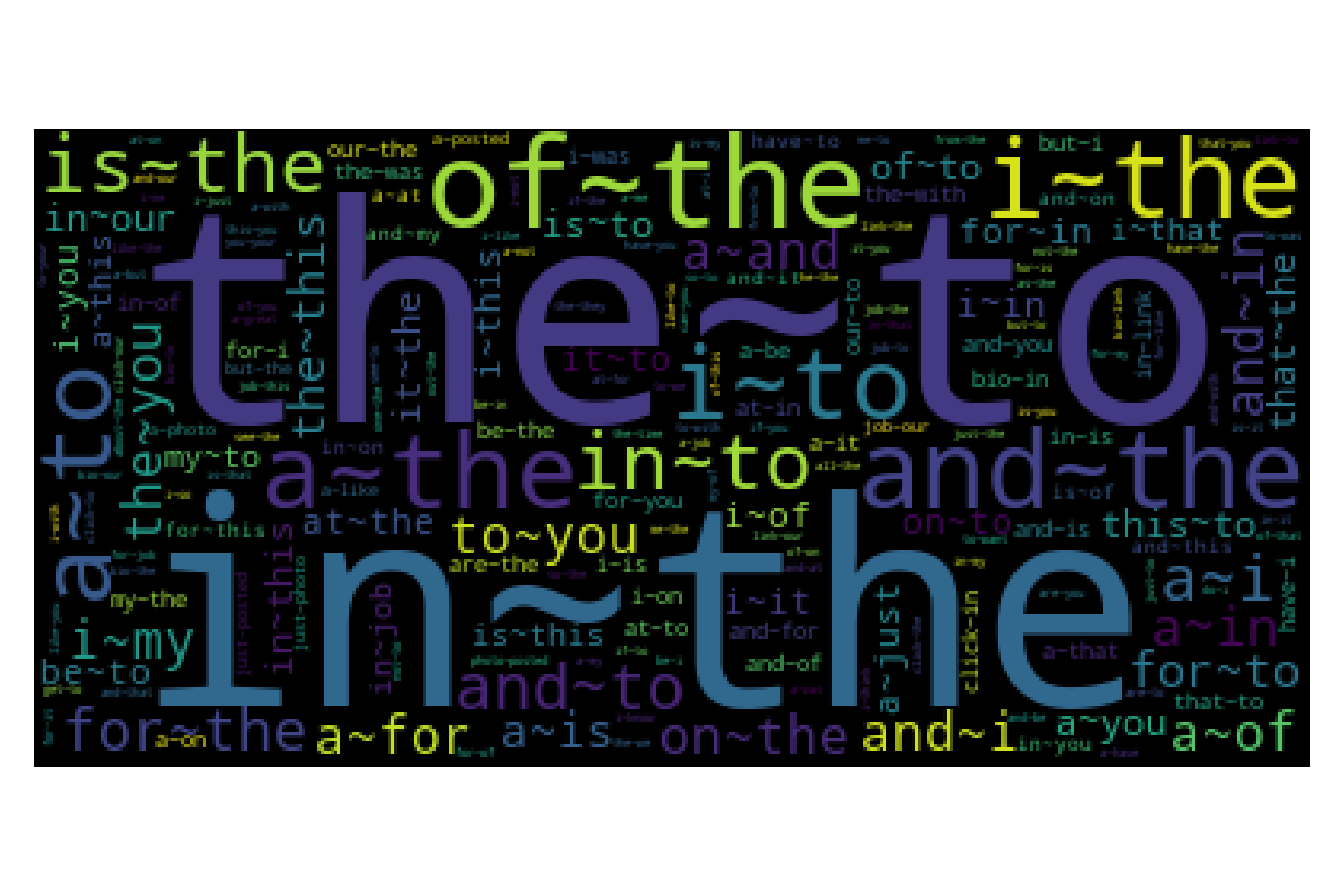
The bivariate matrix is symmetric; therefore, the marginal \(f_{\mathcal X_r}=f_{\mathcal X_c}\) which can be stored in an array (variable M ) as follows:
It can be observed that most of the elements of the bivariate matrix are zero, so instead of using computing the difference between the bivariate distribution and the product of the marginals, it is more efficient to compute only for the pairs that appear in the co-occurrence matrix. The difference can be computed using the following function.
The following table presents the difference matrix for the first five words. It is seen that the diagonal is negative because, by construction, there are no bigrams of the same word. Outside the diagonal, we can see other negative numbers; it seems that these numbers are closed to zero, indicating that these values could be independent.
The word cloud of the difference can be computed using the following code. Those bigrams that have a negative value were discarded because these cannot be considered collocations because the statistic tells that the words do not appear together.
The following figure presents the word cloud of the difference. It can be observed that the main difference between the important bigrams of the former figure and this one is that the former presented mostly stopwords, and this one has other words.

Hypothesis Testing
We have been using the difference between \(\mathbb P(\mathcal X, \mathcal Y) - \mathbb P(\mathcal X) \mathbb P(\mathcal Y)\) to measure whether the variables are dependent or independent. For the case of rolling dices, we saw that when the variables are independent, all the absolute value of the difference is lower than \(0.009\); however, this is by no means a formal definition.
Hypothesis testing aims to measure whether the data collected agrees with a null hypothesis or can be discarted. For example, let us believe that the exposure of a particular substance is the cause of a deadly disease, then the following experiment can be created. On the one hand, there is a group that has been exposed to the substance, and on the other hand, the group has not been exposed. These two groups allow to accept or reject the null hypothesis that the substance is not related to the disease.
In the case at hand, hypothesis testing is helpful to state the dependency or independence of the random variables. One measures whether the estimated bivariate distribution supports the null hypothesis that the variables are independent, i.e., \(\mathcal H_0: \mathbb P(\mathcal X, \mathcal Y) - \mathbb P(\mathcal X) \mathbb P(\mathcal Y) = 0;\) where the alternative hypothesis is \(\mathcal H_1: \mathbb P(\mathcal X, \mathcal Y) - \mathbb P(\mathcal X) \mathbb P(\mathcal Y) \neq 0.\)
One can use different procedures in Hypothesis testing; selecting one of them depends on the characteristics of the random variables and the type of test. We will use two different tests for the problem we are dealing with: the Wald test and the other is Likelihood ratios .
The Wald Test
The Wald test is defined using the \(\hat \theta\) which is the estimation of \(\theta\) and \(\hat{\textsf{se}}\) the estimated standard error of \(\hat \theta\). The null and alternative hypothesis are \(\mathcal H_0: \hat \theta = \theta_0\) and \(\mathcal H_1: \hat \theta \neq \theta_0,\) respectively. Additionally, considering that \(\hat \theta\) is asymptotically normal, i.e., \(\frac{\hat \theta - \theta_0}{\hat{\textsf{se}}} \rightsquigarrow \mathcal N(0, 1),\) it can be defined that the size \(\alpha\) of the Wald test is rejecting \(\mathcal H_0\) when \(\mid W \mid > z_{\frac{\alpha}{2}}\) where
The relationship between \(\hat \theta\), \(\hat{\textsf{se}}\) and \(\theta_0\) with \(\mathbb P(\mathcal X, \mathcal Y)\) and \(\mathbb P(\mathcal X) \mathbb P(\mathcal Y)\) is the following. \(\theta_0\) defines the null hypothesis that in our case is that the variables are independent, i.e., \(\mathbb P(\mathcal X) \mathbb P(\mathcal Y).\) On the other hand, \(\mathbb P(\mathcal X, \mathcal Y)\) corresponds to \(\hat \theta\) and \(\hat{\textsf{se}}\) is the estimated standard error of \(\mathbb P(\mathcal X, \mathcal Y).\)
We can estimate the values for \(\hat \theta\) and \(\theta_0\), the only variable missing is \(\hat{\textsf{se}}\). The standard error is defined as \(\textsf{se} = \sqrt{V(\hat \theta)}\), in this case \(\theta = \mathbb P(\mathcal X_r, \mathcal X_c)\) is a bivariate distribution where the pair of random variables are drawn from a Categorical distribution with parameter \(\mathbf p\). The variance of a Categorical distribution is \(\mathbf p_i = \mathbf p_i (1 - \mathbf p_i),\) and the variance of \(\hat{\mathbf p_i}\) is \(\frac{\mathbf p_i (1 - \mathbf p_i)}{N};\) therefore, \(\hat{\textsf{se}} = \sqrt{\frac{\mathbf p_i (1 - \mathbf p_i)}{N}}.\)
For example, the Wald test for data collected on the two rolling dices example is computed as follows. Variable Z contains the drawn from two dices with the characteristic that \(\mathcal X_r=2\) with a probability \(0.1\) when \(\mathcal X_c=1.\) Variable \(W\) is the estimated bivariate distribution, i.e., \(\theta\), \(\hat{\textsf{se}}\) is identified using W as shown in the second line, and, finally, the third line has the Wald statistic.
The Wald statistic is seen in the following matrix; the absolute value of the elements are compared against \(z_{\frac{\alpha}{2}}\) to accept or reject the null hypothesis. \(z_{\alpha}\) is the inverse of the standard normal distribution (i.e., \(\mathcal N(0, 1)\)) that gives the probability \(1-\alpha\), traditionally \(\alpha\) is \(0.1\) or \(0.05\). For a \(\alpha=0.01\) the value of \(z_{\frac{\alpha}{2}}\) is approximately \(2.58\) (variable c ).
Comparing the absolute values of W against \(2.58\), it is observed that \(\mathcal X_r=2\) and \(\mathcal X_c=1\) are dependent which corresponds to the designed of the experiment, the other pair that is found dependent is \(\mathcal X_r=4\) and \(\mathcal X_c=1.\)
The Wald test can also be applied to the bigrams example , as shown in the following code. The estimated bivariate distribution is found on variable co_occurrence ; given that the matrix is sparse, the Wald statistic is only computed for those elements different than zero.
Variable wald contains the statistic for all the bigrams, then we need to compare it against \(z_{\frac{\alpha}{2}}\); however, in the bigrams case, as mentioned previously, we are interested only on the bigrams that the probability of observing the pair is higher than the product of the marginals.
It can be observed that variable wald has less than 10% of all the bigrams; unfortunately, these are still a lot and cannot be visualized in a table; consequently, we rely on the word cloud shown below.

As can be seen, the most important bigrams are similar to the ones observed on the difference figure ; this is because the former approach and the Wald test are equivalent; the advantage of the Wald test is that there is a threshold that can be used to eliminate uninterested bigrams.
Likelihood ratios
The Wald test assumes normality on the estimation, which is a fair assumption when the number of counts is high; however, for the case of bigrams, as we have seen on the Vocabulary Laws , the majority of words appear infrequent; thus most of the bigrams are also infrequent.
The likelihood ratios are more appropriate for this problem; the idea is to model two hypotheses that encode the behavior of collocations. On the one hand, the first hypothesis is \(\mathcal H_1: \mathbb P(\mathcal X_c=w_2 \mid \mathcal X_r=w_1) = p = \mathbb P(\mathcal X_c=w_2 \mid \mathcal X_r=\neg w_1)\) which corresponds to the independence assumption. On the other hand, the second hypothesis is \(\mathcal H_2: \mathbb P(\mathcal X_c=w_2 \mid \mathcal X_r=w_1) = p_1 \neq p_2 = \mathbb P(\mathcal X_c=w_2 \mid \mathcal X_r=\neg w_1).\) Then the log of the likelihood ratio $\lambda$ is defined as follows:
where \(\mathcal L(\mathcal H_1)\) is the likelihood of observing the counts for words \(w_1\) and \(w_2\) and the bigram \((w_1, w_2)\) that corresponds to the hypothesis \(\mathcal H_1.\) Equivalent, \(\mathcal L(\mathcal H_2)\) corresponds to the likelihood of observing the counts for the second hypothesis.
Using \(c_1\), \(c_2\), and \(c_{12}\) for the count of the words \(w_1\) and \(w_2\) and the bigram \((w_1, w_2)\) the likelihood of the hypothesis are \(\mathcal L(\mathcal H_1)=L(c_{12}, c_1, p)L(c_2-c_{12}, N-c_1, p)\) and \(\mathcal L(\mathcal H_2)=L(c_{12}, c_1, p_1)L(c_2-c_{12}, N-c_1, p_2),\) where \(L(k, n, x) = x^k(1-x)^{n-k}.\)
The first step is to store the counts \(c_1\) and \(c_2\) on the variable count .
The function \(L\) and the ratio can be computed as follows.
The last step is to obtain the statistic for each pair, and select only those bigrams where the null hypothesis (in this case \(\mathcal H_1\)) can be rejected.
The following figure presents the word cloud obtained using the Likelihood method, and please take a minute to compare the three different word clouds produced so far.

As seen in the figures, the bigrams do not clearly indicate the events that occurred on the day, and few bigrams can be considered as a collocation. This behavior is normal; however, we can further analyze the test data to understand their behavior better.
The following figure presents the scatter plot between frequency and Wald statistic. It can be observed that the Wald statistic increases when the frequency increases. This behavior is reflected in the word cloud; the result is that the bigrams appearing are the ones with higher frequency.
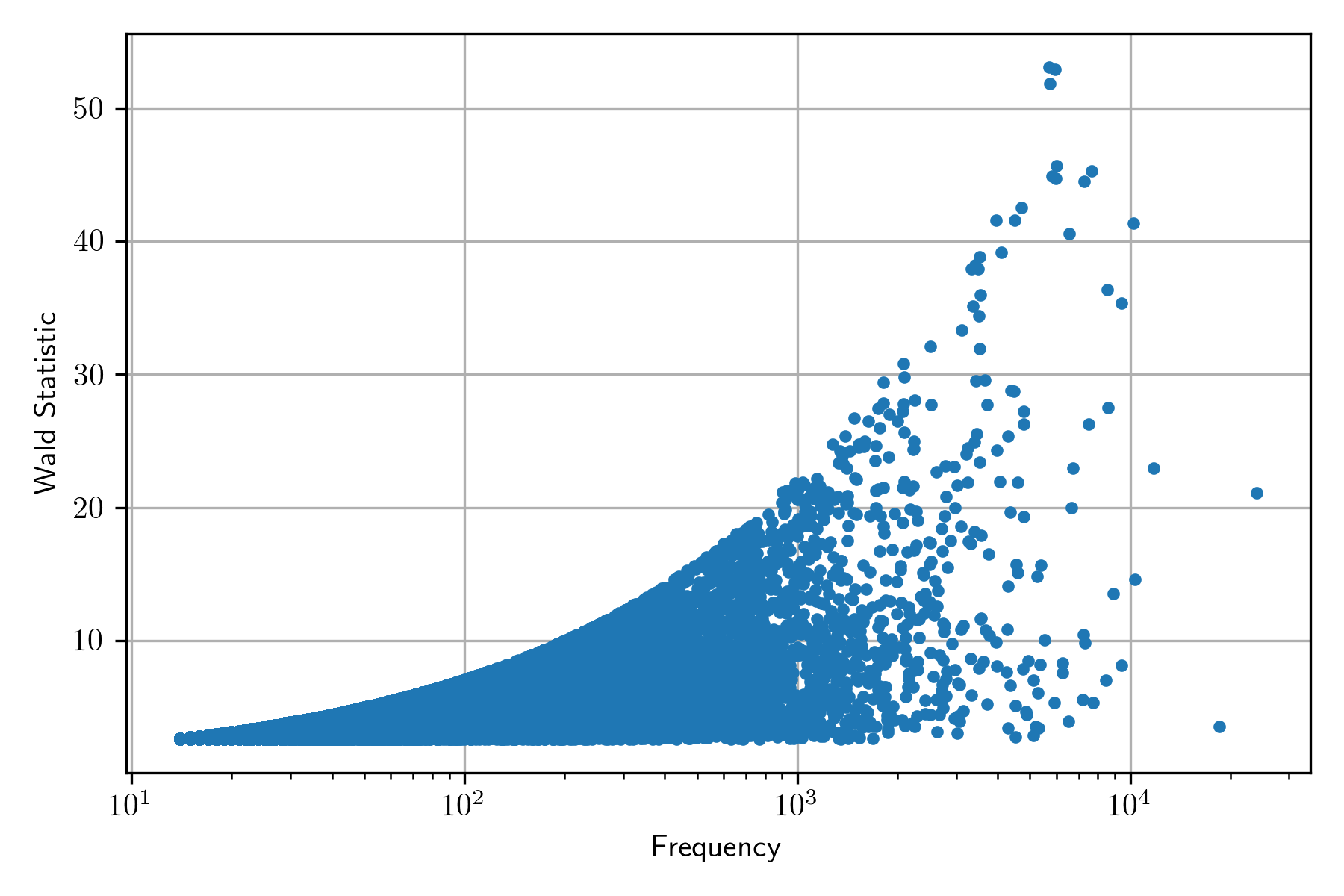
Conversely, the behavior of the Likelihood ratio does not present an increased value when the frequency is increased, as can be seen in the following figure; nonetheless, the word cloud is not as informative as one wishes to be.
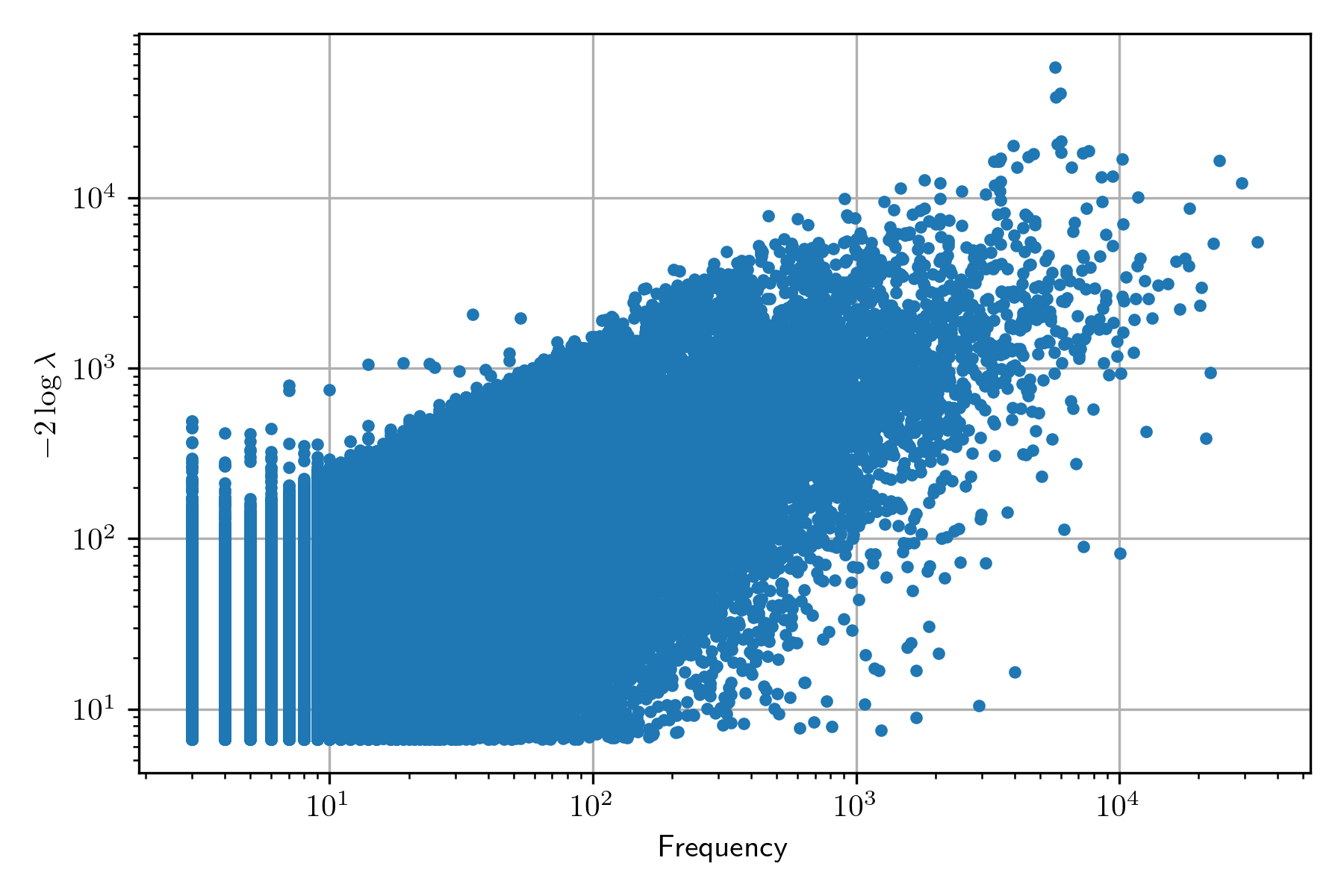
So far, we have used the information of January 10, 2022; in this section, we will be working with January 17, 2022, to complement our analysis of finding collocations through hypothesis testing. The following figure presents the word cloud using the Likelihood test – it is essential to mention that it presents another limitation: it only contains 200 words corresponding to the words with higher values.
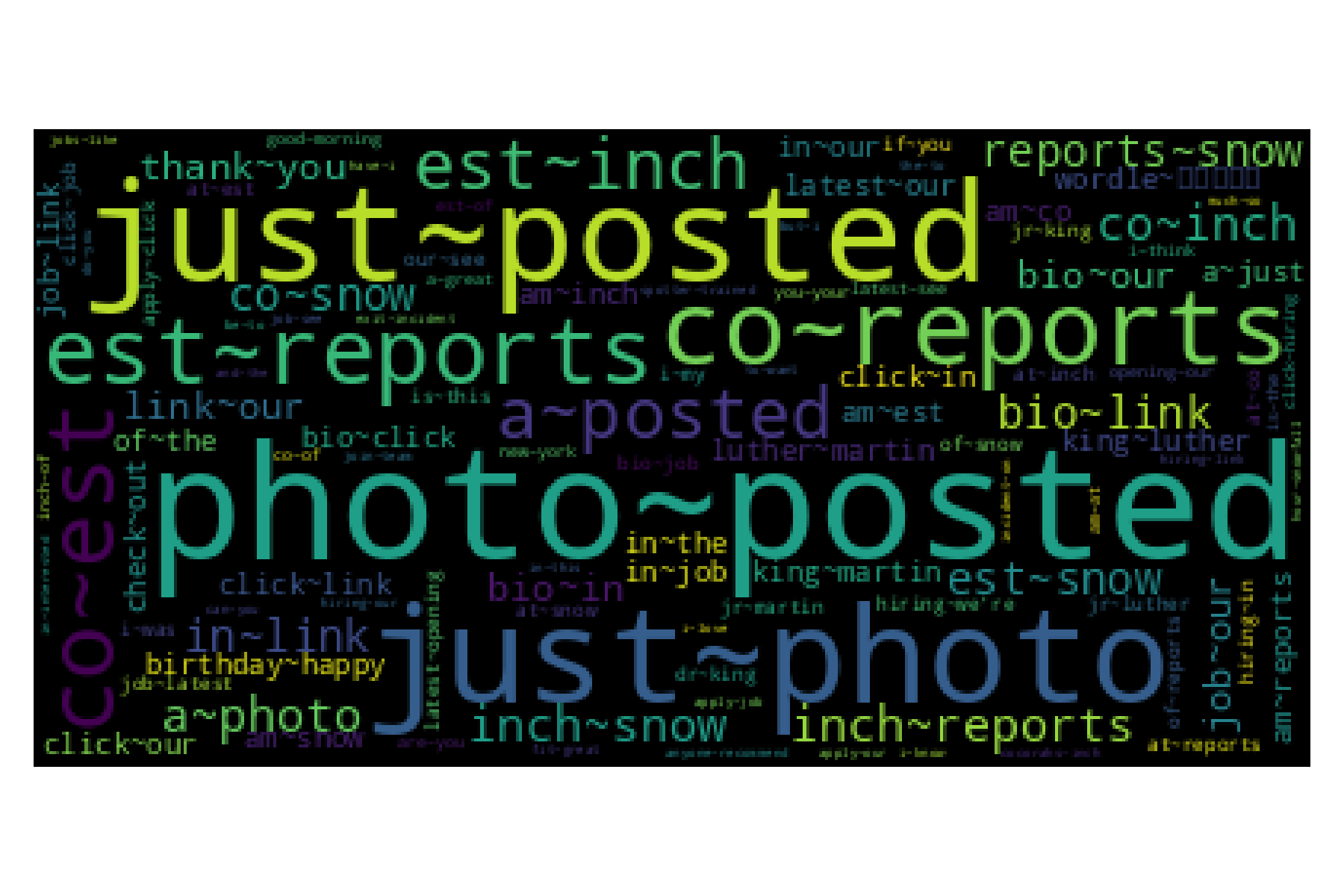
There are some similarities with the word cloud from the other day; however, there are significant differences. For example, it can be inferred that there was snow on that day and Martin Luther King memorial day. The word cloud of the following 200 words is shown below; it can be observed that the recurrent term is snow.

- More from M-W
- To save this word, you'll need to log in. Log In

Definition of hypothesis
Did you know.
The Difference Between Hypothesis and Theory
A hypothesis is an assumption, an idea that is proposed for the sake of argument so that it can be tested to see if it might be true.
In the scientific method, the hypothesis is constructed before any applicable research has been done, apart from a basic background review. You ask a question, read up on what has been studied before, and then form a hypothesis.
A hypothesis is usually tentative; it's an assumption or suggestion made strictly for the objective of being tested.
A theory , in contrast, is a principle that has been formed as an attempt to explain things that have already been substantiated by data. It is used in the names of a number of principles accepted in the scientific community, such as the Big Bang Theory . Because of the rigors of experimentation and control, it is understood to be more likely to be true than a hypothesis is.
In non-scientific use, however, hypothesis and theory are often used interchangeably to mean simply an idea, speculation, or hunch, with theory being the more common choice.
Since this casual use does away with the distinctions upheld by the scientific community, hypothesis and theory are prone to being wrongly interpreted even when they are encountered in scientific contexts—or at least, contexts that allude to scientific study without making the critical distinction that scientists employ when weighing hypotheses and theories.
The most common occurrence is when theory is interpreted—and sometimes even gleefully seized upon—to mean something having less truth value than other scientific principles. (The word law applies to principles so firmly established that they are almost never questioned, such as the law of gravity.)
This mistake is one of projection: since we use theory in general to mean something lightly speculated, then it's implied that scientists must be talking about the same level of uncertainty when they use theory to refer to their well-tested and reasoned principles.
The distinction has come to the forefront particularly on occasions when the content of science curricula in schools has been challenged—notably, when a school board in Georgia put stickers on textbooks stating that evolution was "a theory, not a fact, regarding the origin of living things." As Kenneth R. Miller, a cell biologist at Brown University, has said , a theory "doesn’t mean a hunch or a guess. A theory is a system of explanations that ties together a whole bunch of facts. It not only explains those facts, but predicts what you ought to find from other observations and experiments.”
While theories are never completely infallible, they form the basis of scientific reasoning because, as Miller said "to the best of our ability, we’ve tested them, and they’ve held up."
- proposition
- supposition
hypothesis , theory , law mean a formula derived by inference from scientific data that explains a principle operating in nature.
hypothesis implies insufficient evidence to provide more than a tentative explanation.
theory implies a greater range of evidence and greater likelihood of truth.
law implies a statement of order and relation in nature that has been found to be invariable under the same conditions.
Examples of hypothesis in a Sentence
These examples are programmatically compiled from various online sources to illustrate current usage of the word 'hypothesis.' Any opinions expressed in the examples do not represent those of Merriam-Webster or its editors. Send us feedback about these examples.
Word History
Greek, from hypotithenai to put under, suppose, from hypo- + tithenai to put — more at do
1641, in the meaning defined at sense 1a
Phrases Containing hypothesis
- nebular hypothesis
- null hypothesis
- counter - hypothesis
- planetesimal hypothesis
- Whorfian hypothesis
Articles Related to hypothesis

This is the Difference Between a...
This is the Difference Between a Hypothesis and a Theory
In scientific reasoning, they're two completely different things
Dictionary Entries Near hypothesis
hypothermia
hypothesize
Cite this Entry
“Hypothesis.” Merriam-Webster.com Dictionary , Merriam-Webster, https://www.merriam-webster.com/dictionary/hypothesis. Accessed 12 Apr. 2024.
Kids Definition
Kids definition of hypothesis, medical definition, medical definition of hypothesis, more from merriam-webster on hypothesis.
Nglish: Translation of hypothesis for Spanish Speakers
Britannica English: Translation of hypothesis for Arabic Speakers
Britannica.com: Encyclopedia article about hypothesis
Subscribe to America's largest dictionary and get thousands more definitions and advanced search—ad free!

Can you solve 4 words at once?
Word of the day.
See Definitions and Examples »
Get Word of the Day daily email!
Popular in Grammar & Usage
Your vs. you're: how to use them correctly, every letter is silent, sometimes: a-z list of examples, more commonly mispronounced words, how to use em dashes (—), en dashes (–) , and hyphens (-), absent letters that are heard anyway, popular in wordplay, the words of the week - apr. 12, 10 scrabble words without any vowels, 12 more bird names that sound like insults (and sometimes are), 8 uncommon words related to love, 9 superb owl words, games & quizzes.

- Dictionaries home
- American English
- Collocations
- German-English
- Grammar home
- Practical English Usage
- Learn & Practise Grammar (Beta)
- Word Lists home
- My Word Lists
- Recent additions
- Resources home
- Text Checker
Definition of hypothesize verb from the Oxford Advanced Learner's Dictionary
hypothesize
- The causes can be hypothesized but not proved.
- We can only hypothesize that the cases we know about are typical.
- Let us try to hypothesize a particular market situation.
- There are particular problems that arise when hypothesizing about the origins of the universe.
Questions about grammar and vocabulary?
Find the answers with Practical English Usage online, your indispensable guide to problems in English.
Nearby words
Nominal Collocations in Scientific English: A Frame-Semantic Approach
- Conference paper
- First Online: 18 September 2019
- Cite this conference paper
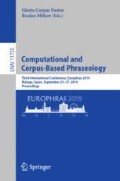
- Eva Lucía Jiménez-Navarro 10
Part of the book series: Lecture Notes in Computer Science ((LNAI,volume 11755))
Included in the following conference series:
- International Conference on Computational and Corpus-Based Phraseology
774 Accesses
1 Citations
In the last two decades, interest in the role played by phraseological units in the discourse of science has grown. Linguists have agreed that collocational frameworks help to structure the text and display a more restricted set of senses when used in this context. This paper aims at contributing to the study of collocations in the research article (RA). To this end, more than 400 collocations are analyzed in terms of Fillmore’s Frame Semantics theory. Our methodology is corpus-based and explores adjective + noun open domain collocations extracted from the British National Corpus (BNC) in a specific corpus of more than three million words. The findings suggest that these collocations convey specific meanings when they are used in this genre, being the headword the element evoking the semantic frame of the combination and the collocate expressing a feature of the former. The frames evoked reflect the semantics of science and their combination shows the anatomy of the RA.
This is a preview of subscription content, log in via an institution to check access.
Access this chapter
- Available as PDF
- Read on any device
- Instant download
- Own it forever
- Available as EPUB and PDF
- Compact, lightweight edition
- Dispatched in 3 to 5 business days
- Free shipping worldwide - see info
Tax calculation will be finalised at checkout
Purchases are for personal use only
Institutional subscriptions
Firth, J.R.: Papers in Linguistics, 1934-1951. Oxford University Press, London (1957)
Google Scholar
Halliday, M.A.K.: Categories of the theory of grammar. Word 17 , 241–292 (1961)
Article Google Scholar
Sinclair, J.: Corpus, Concordance, Collocation. Oxford University Press, Oxford (1991)
Vinogradov, V.V.: Izbrannye Trudy. Leksikologija i leksikografija. Nauka, Moscow (1947)
Cowie, A.P.: Phraseology: Theory, Analysis, and Applications. Clarendon Press, Oxford (1998)
Howarth, P.A.: Phraseology in English Academic Writing. Some Implications for Language Learning and Dictionary Making. Niemeyer, Tübingen (1996)
Book Google Scholar
Evert, S.: Corpora and collocations. In: Lüdeling, A., Kytö, M. (eds.) Corpus Linguistics: An International Handbook, pp. 1212–1248. Walter de Gruyter, Berlin/New York (2008)
Pęzik, P.: Facets of Prefabrication. Perspectives on Modelling and Detecting Phraseological Units. Łódź University Press, Łódź (2018)
Tognini-Bonelli, E.: Corpus Linguistics at Work. John Benjamins Publishing Company, Amsterdam/Philadelphia (2001)
The British National Corpus, version 3 (BNC XML Edition). Distributed by Bodleian Libraries, University of Oxford, on behalf of the BNC Consortium (2007). http://www.natcorp.ox.ac.uk/ . Accessed 15 Apr 2019
Biber, D., Barbieri, F.: Lexical bundles in university spoken and written registers. Engl. Specif. Purp. 26 (3), 263–286 (2007)
Luzón Marco, M.J.: Collocational frameworks in medical research papers: a genre-based study. Engl. Specif. Purp. 19 , 63–86 (2000)
Verdaguer, I., González, E.: A lexical database of collocations in scientific English: preliminary considerations. In: Williams, G., Vessier, S. (eds.) Proceedings of the Eleventh EURALEX International Congress, EURALEX 2004, pp. 929–934. Université de Bretagne-Sud, Lorient (2004)
Stuart, K., Botella, A.: Collocation and knowledge production in an academic discourse community. In: Neuman, C.-P., Plo Alastrué, R., Pérez-Llantada, C. (eds.) Proceedings of the 5th International AELFE Conference, pp. 238–245. Universidad de Zaragoza, Prensas Universitarias de Zaragoza, Zaragoza (2006)
Gledhill, C.: Colligation and the cohesive function of present and past tense in the scientific research article. In: Banks, D. (ed.) Les Temps et les Textes de Spécialité, pp. 65–84. L’Harmattan, Paris (2009)
Menon, S., Mukundan, J.: Analysing collocational patterns of semi-technical words in science textbooks. Pertanika J. Soc. Sci. Humanit. (JSSH) 18 (2), 241–258 (2010)
Pérez-Llantada, C.: Formulaic language in L1 and L2 expert academic writing: convergent and divergent usage. J. Engl. Acad. Purp. 14 , 84–94 (2014)
Sketch Engine. https://www.sketchengine.co.uk . Accessed 15 Apr 2019
Fillmore, C.J.: Frame semantics. In: Linguistic Society of Korea (ed.) Linguistics in the Morning Calm, pp. 111–137. Hanshin Publishing Company, Seoul (1982)
Fillmore, C.J.: Frames and the semantics of understanding. Quaderni di Semantica 6 (2), 222–254 (1985)
Fillmore, C.J.: Frame semantics. In: Geeraerts, D., Dirven, R., Taylor, J.R. (eds.) Cognitive Linguistics: Basic Readings, pp. 373–400. Mouton de Gruyter, Berlin/New York (2006)
Chapter Google Scholar
FrameNet Project. https://framenet.icsi.berkeley.edu/fndrupal/ . Accessed 15 Apr 2019
Halliday, M.A.K.: The Language of Science. Continuum, London (2004)
Download references
Author information
Authors and affiliations.
Department of English and German, University of Córdoba, Córdoba, Spain
Eva Lucía Jiménez-Navarro
You can also search for this author in PubMed Google Scholar
Corresponding author
Correspondence to Eva Lucía Jiménez-Navarro .
Editor information
Editors and affiliations.
University of Malaga, Malaga, Spain
Gloria Corpas Pastor
University of Wolverhampton, Wolverhampton, UK
Ruslan Mitkov
Rights and permissions
Reprints and permissions
Copyright information
© 2019 Springer Nature Switzerland AG
About this paper
Cite this paper.
Jiménez-Navarro, E.L. (2019). Nominal Collocations in Scientific English: A Frame-Semantic Approach. In: Corpas Pastor, G., Mitkov, R. (eds) Computational and Corpus-Based Phraseology. EUROPHRAS 2019. Lecture Notes in Computer Science(), vol 11755. Springer, Cham. https://doi.org/10.1007/978-3-030-30135-4_14
Download citation
DOI : https://doi.org/10.1007/978-3-030-30135-4_14
Published : 18 September 2019
Publisher Name : Springer, Cham
Print ISBN : 978-3-030-30134-7
Online ISBN : 978-3-030-30135-4
eBook Packages : Computer Science Computer Science (R0)
Share this paper
Anyone you share the following link with will be able to read this content:
Sorry, a shareable link is not currently available for this article.
Provided by the Springer Nature SharedIt content-sharing initiative
- Publish with us
Policies and ethics
- Find a journal
- Track your research

Definition of 'hypothesis'

Video: pronunciation of hypothesis

hypothesis in American English
Hypothesis in british english, examples of 'hypothesis' in a sentence hypothesis, related word partners hypothesis, trends of hypothesis.
View usage over: Since Exist Last 10 years Last 50 years Last 100 years Last 300 years
In other languages hypothesis
- American English : hypothesis / haɪˈpɒθɪsɪs /
- Brazilian Portuguese : hipótese
- Chinese : 假设
- European Spanish : hipótesis
- French : hypothèse
- German : Hypothese
- Italian : ipotesi
- Japanese : 仮説
- Korean : 가설
- European Portuguese : hipótese
- Spanish : hipótesis
- Thai : สมมุติฐาน
Browse alphabetically hypothesis
- hypothermia
- hypothermic
- hypothesis states
- hypothesis suggests
- hypothesis testing
- All ENGLISH words that begin with 'H'
Related terms of hypothesis
- Gaia hypothesis
- null hypothesis
- initial hypothesis
- View more related words
Quick word challenge
Quiz Review
Score: 0 / 5

Wordle Helper

Scrabble Tools

- Cambridge Dictionary +Plus
alternative hypothesis
Meanings of alternative and hypothesis.
Your browser doesn't support HTML5 audio
(Definition of alternative and hypothesis from the Cambridge English Dictionary © Cambridge University Press)
- Examples of alternative hypothesis
{{message}}
Please choose a part of speech and type your suggestion in the Definition field.
Help us improve the Cambridge Dictionary
alternative hypothesis doesn't have a definition yet. You can help!

Word of the Day
acting or speaking together, or at the same time

Alike and analogous (Talking about similarities, Part 1)

Learn more with +Plus
Thank you for suggesting a definition! Only you will see it until the Cambridge Dictionary team approves it, then other users will be able to see it and vote on it.
See your definition
- Recent and Recommended {{#preferredDictionaries}} {{name}} {{/preferredDictionaries}}
- Definitions Clear explanations of natural written and spoken English English Learner’s Dictionary Essential British English Essential American English
- Grammar and thesaurus Usage explanations of natural written and spoken English Grammar Thesaurus
- Pronunciation British and American pronunciations with audio English Pronunciation
- English–Chinese (Simplified) Chinese (Simplified)–English
- English–Chinese (Traditional) Chinese (Traditional)–English
- English–Dutch Dutch–English
- English–French French–English
- English–German German–English
- English–Indonesian Indonesian–English
- English–Italian Italian–English
- English–Japanese Japanese–English
- English–Norwegian Norwegian–English
- English–Polish Polish–English
- English–Portuguese Portuguese–English
- English–Spanish Spanish–English
- English–Swedish Swedish–English
- Dictionary +Plus Word Lists
There was a problem sending your report.
- Definition of alternative
- Definition of hypothesis
- Add a definition
- All translations

IMAGES
VIDEO
COMMENTS
Collocations Scientific research Scientific research Theory. formulate/ advance a theory/ hypothesis; build/ construct/ create/ develop a simple/ theoretical/ mathematical model; develop/ establish/ provide/ use a theoretical/ conceptual framework; advance/ argue/ develop the thesis that…; explore an idea/ a concept/ a hypothesis; make a prediction/ an inference
hypothesis - OZDIC - English collocation examples, usage and definition. ↺. figure asset blow respect box gap. OZDIC - English Collocation Dictionary.
Examples of STUDY HYPOTHESIS in a sentence, how to use it. 18 examples: Interviewees, but not interviewers, were blinded to the study hypothesis. - This finding, thus…
1 [countable] an idea or explanation of something that is based on a few known facts but that has not yet been proved to be true or correct synonym theory to formulate/confirm a hypothesis a hypothesis about the function of dreams There is little evidence to support these hypotheses. Topic Collocations Scientific Research theory. formulate/advance a theory/hypothesis
What is a collocation? A collocation is two or more words that often go together. These combinations (for example collocations with "HYPOTHESIS") just sound "right" to native English speakers, who use them all the time.On the other hand, other combinations of "HYPOTHESIS" may be unnatural and just sound "wrong".. Using collocations list of "HYPOTHESIS" improves your English ...
Here's one example of an academic collocation: Correct Collocation: A scholar's job is to search for evidence that supports their hypothesis. Improper Collocation: A scholar's job is to research evidence that supports their hypothesis. If you're unsure about how to use collocations, several online collocation dictionaries can help.
From Longman Business Dictionary hypothesis hy‧poth‧e‧sis / haɪˈpɒθəsəs-ˈpɑː-/ noun (plural hypotheses /-siːz /) [countable] STATISTICS an idea that can be tested to see if it is true or not These results support the hypothesis that individuals are willing to pay more in order to live in communities that provide high-quality ...
HYPOTHESIS meaning: 1. an idea or explanation for something that is based on known facts but has not yet been proved…. Learn more.
3 meanings: 1. a suggested explanation for a group of facts or phenomena, either accepted as a basis for further verification.... Click for more definitions.
OZDIC English Collocation Dictionary is designed to help language learners and users write and speak natural-sounding English.. It provides a comprehensive guide to the most frequently used word combinations, including both common and idiomatic expressions. Your benefits of using the OZDIC : . Enhanced accuracy and fluency : understanding collocations can help learners use the right words in ...
7.1.1 Collocation as a quantitative phenomenon. Essentially, then, collocation is just a special case of the quantitative corpus linguistic research design adopted in this book: to ask whether two words form a collocation (or: are collocates of each other) is to ask whether one of these words occurs in a given position more frequently than expected by chance under the condition that the other ...
A collocation is an expression with the characteristic that its meaning cannot be inferred by simply adding the definition of each of its words, e.g., kick the bucket. ... in this section, we will be working with January 17, 2022, to complement our analysis of finding collocations through hypothesis testing. The following figure presents the ...
with natural collocations), and corpus linguistic research (for instance, the study of social phenomena like the reinforcement of cultural stereotypes through language (Stubbs 1996)). There is much interest in collocations partly because this is an area that has been neglected in structural linguistic traditions that follow Saussure and Chomsky.
Competing in a Global Economy. ( 1990) His colleagues must surely be asking themselves whether they really need to test this hypothesis before making a change. Times, Sunday Times. ( 2011) First, that the lifestyle concept suggests hypotheses which are true by definition and therefore trivial.
Collocations are sequences of strongly related words in a text; there is often an associative relationship between terms that form collocations. The chapter points out the relevance of collocation analysis for humanities through the concept of associative relationship. What this means in practice is explained through a collocation, "limping ...
hypothesis: [noun] an assumption or concession made for the sake of argument. an interpretation of a practical situation or condition taken as the ground for action.
Examples of INDUCTION HYPOTHESIS in a sentence, how to use it. 18 examples: It is easy to prove most cases by applying the induction hypothesis on the premises of each rule…
hypothesize (something) | hypothesize that… to suggest a way of explaining something when you do not definitely know about it; to form a hypothesis The causes can be hypothesized but not proved. We can only hypothesize that the cases we know about are typical. Let us try to hypothesize a particular market situation.
Chapter2 On Collocations. Chapter2. On Collocations. 2.1 Introduction. The phenomenon of collocating words was brought to the attention of linguists in the 1930s by the British contextualist John R. Firth, who actually popularized the termcollocation, derived from the Latin wordcollocare("to place together, to assemble").
Our hypothesis is that collocations convey specific meanings when they are examined in specialized discourse, specifically in scientific discourse. In order to prove this hypothesis, we will rely on corpus data compiled for this purpose. Therefore, the main aim of this paper is to give some insights into the relation between collocations and ...
a suggested explanation for a group of facts or phenomena, either accepted as a basis for further verification ( working hypothesis) or accepted as likely to be true. Compare theory (sense 5) 2. an assumption used in an argument without its being endorsed; a supposition. 3. an unproved theory; a conjecture.
Examples of how to use "alternative hypothesis" in a sentence from Cambridge Dictionary.
Collocation is a fundamental feature of language in which sequences of words take on the properties of fixed expressions. This book analyses the role of collocation in science writing.